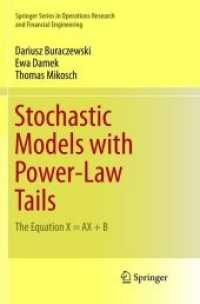- ホーム
- > 洋書
- > ドイツ書
- > Mathematics, Sciences & Technology
- > Technology
- > mechanical engineering & production engineering
Description
(Text)
A virtual replica of a system test bench for full-scale wind turbine nacelle is built up in
the framework of this dissertation. The primary objective of the simulation study is to
reveal the overall dynamics of the test bench and expose the difference between test
bench dynamics and wind turbine field dynamics. The secondary objective is to make
proper use of the developed models and design active control schemes for test bench
operation.
The virtual test bench is formulated in a multi-body simulation environment, with
flexible drive train dynamics validated with experimental modal testing. The model also
integrates the operation control and DUT control, having a similar hardware-in-the-loop
architecture as the physical test bench. The data exchange between multi-body model
and controllers is realized through co-simulation interface. Test scenarios with aeroelastic wind load calculation can be simulated.
By comparing the interface force/torque response with the reference turbine model, it is found that the open-loop behavior of the tested nacelle explicitly differs from field
operation. The changed boundary conditions of the tested nacelle are the root cause of the difference since the inertia and stiffness of the load application system largely differ from the original rotor system of the turbine. It is also found that the rheonomic joint is the reason why coupled rotor-drive train dynamics are lost when using the wind load software simulator.
The difference of open-loop behavior is compensable via active control. A virtual rotor
system can be artificially created to excited realistic load response inside the DUT as in
field operation. However, the existing multi-body model has hundreds of states and thus computationally expensive. Therefore, low-order plant models in form of transfer
elements were derived from the multi-body model by truncating high-order modes at
designed operation points. The low-order models are feasible to represent the dominant dynamics of the test bench while maintaining the accuracy.
This model-based approach enables convenient design and tuning of control frameworks.
Control schemes corresponding to torque and non-torque load control are proposed
respectively and then put together. Resonances inside the tested nacelle can then be
effectively excited as observed in the simulated turbine field operation. The load application bandwidth is however limited by the dominant dynamics of the test bench.








